Computing Everyday in Fourth Grade
By Valerie Baxter | October 18, 2018
Valerie Baxter has spent most of her 25 years teaching in a suburban Chicago school district after starting her career in Indiana. She's had a number of jobs in education including teaching special education, being an assistant principal and now teaching general education. She is currently in her second year of teaching 4th grade after six in 2nd grade. While reading and literacy is her first love in teaching, she's also found a passion in teaching mathematics.
Can I share a secret? When I first saw the Donorschoose announcement about Pathfinders Summer Institute, what drew me to it was that it was a week on the Indiana University campus. My alma-mater. Spending a week living in the dorms, eating dorm food, walking the campus made me feel like I was reliving my college days; however this week of learning was nothing like my college days. This week was transformative as I learned about the importance of computer science in our daily lives and the importance of how to get it into my instruction in my classroom. Most importantly, I learned so much that waiting the four weeks before school started was almost unbearable!
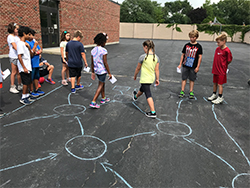
The 550 participants attended a week long class that addressed our particular area of interest. Besides the class, we also had a welcoming ceremony that made me realize how important and imperative it is as teachers that we teach our students about computer science. The ceremony was filled with speakers from the head of the Infosys Foundation to the Governor of Indiana as well as the President of Indiana University’s wife. They all highlighted how our world has changed and computers are an integral part of that world. All jobs WILL require the ability to use computers. After our classes during the week, there were break out sessions where we got to learn a little about what the other classes were doing as well as see IU’s School of Education and School of Informatics, Computing and Engineering. We were able to network with educators from all over the country as we all eagerly shared our stories.
My class, Everyday Computing, was filled with elementary educators who were from all over the country. We had classroom teachers as well as instructional coaches. There was also a huge variety of technology available in the schools and classrooms of the participants. Some (like my school) were one to one, while others had only a few computers or access to a computer cart a few days a week. The class was taught by Carla Strickland, Todd Lash, and Maya Israel from everydaycomputing.org
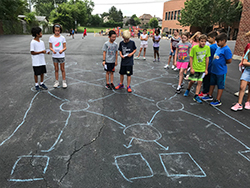
The purpose of the class was to teach us how to integrate computer science into our daily instruction rather than making it a separate class. The main focus was giving us activities to use in our mathematics instruction. Their focus was math, because as students receive services for special education, EL, or intervention they are often pulled out of science and social studies. Math is an area that every student receives instruction. Math is also an area that students often say that they don’t like and what better way to help students like math instruction than by using one thing they universally show they DO like? Computers!
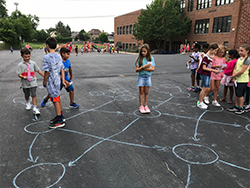
What I found was that while many of the activities do relate to mathematics, they also relate to helping to build a community in my classroom as well as growth mindset. The activities that we did in Everyday Computing really started to create my vision of the beginning of the school year activities. We did a lot of the activities that we could then bring back to our classrooms. There were a lot of “unplugged” activities that help teach the basics behind computer programming while not needing an actual computer.
The first week of school with my fourth graders, we did the Sorting Network activity outside. Students wrote their favorite number and then were “sorted.” Their “ah-ha” moment was when they realized it sorted them in numeric order! We also had problem solving opportunities when students had the same favorite number and if it mattered which way they went. Then we made projections about what might happen if we reversed the directions and seeing what that did to the end product. We also did their favorite multiplication facts. While the correlation to math is obvious, students were also working together solving problems that came up together. They were also learning about computer programming.
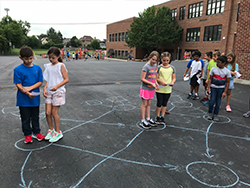
Another unplugged activity that we did the first week was Traveling Circuits by Thinkersmith. In this task, students are asked to act like a programmer and partner up with a “computer.” The programmer creates a program that the computer has to execute exactly. The students are collaborating with partners, while also learning how to help a partner without telling them exactly what to do.
We also used the program Scratch a lot in our Everyday Computing class. While I had a very basic knowledge of it, we worked on becoming more familiar with it as well as how to use it with our students. The work with Scratch has made me not only confident to use Scratch myself to make projects, but also to meet the needs of a variety of computer programming skill levels of my students. One of my classmates created an introductory program so students would get the basics. I also pointed out that there was a bug with it when I recorded it, which I then asked the students to work on it.
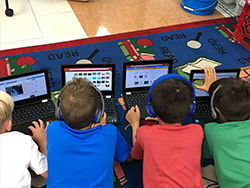
Circling back to the comment about Everyday Computing building activities for growth mindset, one of the first “ah-ha” moments I had in Everyday Computing was when we were told bugs or mistakes would happen in Scratch. It’s a natural part of programming. One of my bugs in Scratch actually created a beautiful kaleidoscope of colors, but that wasn’t the intended outcome. The first day of school, as I talked about mistakes and that they are part of coding and part of life, I showed them my bug. We talked about calling our mistakes “bugs” in class to take the stigma out of the word mistake. Already on day five of school students are using that term when they make a mistake - and we are celebrating that!
As I look at the opinion papers my students wrote, I can already tell that they are hooked on Coding. The paper that was on the top of the pile was an opinion piece about having a coding club, because all the students in the class like Scratch. She just learned it last week. Little does she know, it’s already going to happen. Going forward in the school year in addition to a club, Scratch and other activities will be incorporated into my instruction particularly in math. There will be a number of the other unplugged activities that I will do as part of “challenges” that I like to give my students to get them working in groups or partners for a common goal.
#InfyPathfinders #CSforall #EverydayComputing






